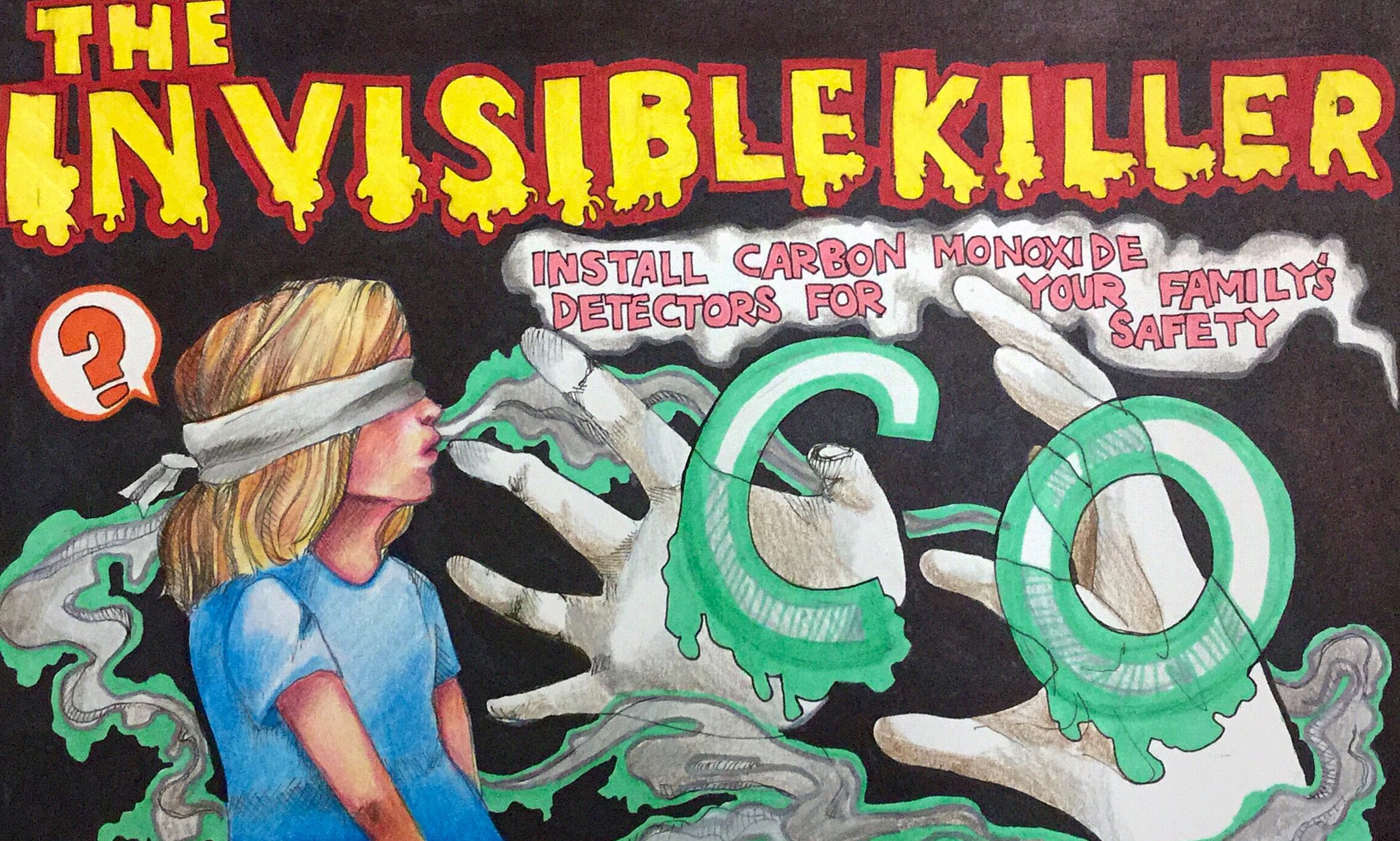Carbon Monoxide Poster Contest
Consumer Product Safety Commission (CPSC)
Summary
Each year, about 400 people in the United States die from unintentional carbon monoxide (CO) poisoning. The CO in these incidents comes from fuel-burning appliances, such as furnaces, gas ranges, water heaters, portable generators and charcoal grills, and from motor vehicles. The CPSC's Carbon Monoxide Safety Poster Contest is designed to educate middle school students about carbon monoxide poisoning dangers and prevention. Students participating in the contest review available information about CO and use their creativity to make posters warning others of the dangers of CO, "the invisible killer."

The winning poster for the CPSC Carbon Monoxide challenge features a blindfolded woman breathing in carbon monoxide, depicted as the "invisible killer." (Image courtesy of CPSC)
The primary objective of CPSC's poster contest is to prevent carbon monoxide poisoning injuries and deaths by increasing CO safety awareness and residential use of CO alarms. CPSC works to engage and educate communities nationwide and on military bases around the world with this poster contest. The students will hopefully use this knowledge to prevent carbon monoxide poisoning in their homes.
CPSC's 2015 poster contest challenge offered $500 each to nine finalists, including three each in sixth, seventh and eighth grade; $500 to one finalist chosen by public vote on CPSC's website; and an additional $1,000 to the grand prize winner. Prize money totaled $6,000 and came from the budget of CPSC's Office of Communications.
Results
CPSC successfully engaged middle school students on the dangers of CO with its poster contest. In 2015, the poster contest challenge received a record 700 entries from middle school students across the United States and U.S. military bases overseas. This represents a 75 percent increase in the number of entries over CPSC's previous poster contests. CPSC announced the 2015 poster contest winners in May 2015 on CPSC's blog, OnSafety. Because the winners are all minors, CPSC posted only their first names, grades and home states to protect their privacy.
Areas of Excellence
Areas of Excellence #1: "Prioritize Goals and Outcomes"
The primary goal of the poster contest is to help raise awareness about the dangers of carbon monoxide poisoning associated with consumer products. The larger, long-term objective is to prevent injuries and deaths from carbon monoxide poisoning in the years ahead. Middle school students are challenged to educate themselves about CO dangers and to create a compelling and attention-grabbing poster to showcase what they learned and steps they should take to protect themselves and their families from carbon monoxide poisoning. Students developed novel approaches to their posters, including a colorful drawing of a canary with the words: "Keep the canary singing. You shouldn't rely on a canary to warn you about carbon monoxide. Install a carbon monoxide detector in your home." Another winner drew a blindfolded girl, who could not see or smell the carbon monoxide floating around her, coupled with the words: "The invisible killer. Odorless, colorless, tasteless—can kill within minutes." Another student created a poster depicting "Codie the CO safety cat" teaching kids about carbon monoxide dangers.
Area of Excellence #2: "Develop Submission Requirements"
CPSC limited the poster contest to middle school students in sixth, seventh and eighth grades. Students must create posters on their own, without help from family, friends or others.
Students can use any poster topic involving CO safety. CPSC suggested the following possible poster topics:
- Facts about CO You cannot see it or smell it. CO is an invisible killer.
- What steps you can take to protect against CO poisoning
- How to recognize CO exposure and symptoms
- How to install and test CO alarms and why they are important
Contest rules required students to submit their poster entries online. Because the contest involves children under the age of 13, CPSC's priority is their safety and privacy. CPSC complies with the Children's Online Privacy Protection Act of 1998 (COPPA) and its accompanying regulations protecting the privacy of children using the Internet. CPSC requires verifiable parental consent via a contest submission and parental consent form for all contestants. In the contest rules, CPSC states that the agency will collect and publish a minimal amount of information about the contestants along with their posters, and will include only their first names, grade levels and states of residence.
Area of Excellence #3: "Execute the Communications Plan"
CPSC publicized the CO poster contest with direct appeals to middle school science and art teachers in dozens of school districts across the United States and in U.S. military schools overseas. CPSC also requested help from the National Fire Protection Association, the U.S. Fire Administration and the Girl Scouts to publicize the contest; and the agency contacted teachers who had taken part in CPSC's previous poster contest to tell them about the new poster contest challenge.
Challenge Type
Design
CPSC's carbon monoxide poster contest challenged students to create a work of art that not only looked appealing, but also had a strong educational message about a dangerous killer right in their own homes, carbon monoxide. Students were also challenged to show how CO could be prevented with carbon monoxide alarms and other safety measures.
Legal Authority
America COMPETES Act

